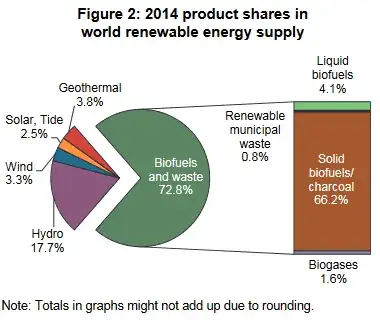NO, (or YES dependent on the definition of primary energy) as answer to the claim: "Wind power does not account for less than half a percent of total global energy usage in 2014."
The wording of the report (from Jordys answer)indicates that they compared electrical output of renewables to the energy contents of combustibles. Putting these on the same graph can be wrong depending on the definition of primary energy.
The caveat of this answer is that it is based on the definition of primary energy. The authors should have mentioned it, if they made the analysis while regarding the difference between primary and secondary energy for renewables. As they didn't, they most likely used the less favourable definition of primary energy with regard to renewables.
Supporting claims based on primary and secondary energy definitions (NO as answer)
Primary energy (1,3) is the energy contained in a fuel. So to speak the released heat in perfect combustion. Unburnt fuel is part of many energy conversion cycles. It is not the generated useful energy.
Non-Fuel based primary energy would be the input to the system, not the generated useful energy. For wind turbines this would be the energy contained in the wind, a perfect wind turbine can only get around 60% of the winds energy (Betz's law). For solar we have around 15-20% conversion efficiency. Therefore the primary energy of renewables is many times higher than the listed numbers.
Secondary energy (1,3) is the energy of energy carriers, these are for example fuels and electricity. Fuel can be an input for electricity generation, so even there are subclasses regarding the quality of the secondary energy. (Oil would be primary, gasoline a secondary energy in some regards, even though we don't use all of the energy in gasoline either)
Exaggerated alternative data (just to make a point)
Primary solar energy heats the earth during the whole year, if we assume that heating needs(relative to the avg temperature of space of a few Kelvin) are met by solar power, we get about 99.9+% (didn't calculate it actually) of the primary energy in solar.
Counterargument (YES as answer)
A claim arguing that the definition of primary energy is usually as probably envisioned by the authors of the Energy Report, from Ref 3:
The primary energy is transformed to secondary energy in the form of
electrical energy or fuel, such as gasoline, fuel oil, methanol,
ethanol, and hydrogen. The primary energy of renewable energy
sources, such as sun, wind, biomass, geothermal energy, and flowing
water is usually equated with either electrical or thermal energy
produced from them.
Caveat: Thermal energy from the sun heats buildings passively.
Conclusion
No as answer
The graphs compare apples to oranges. Primary wind power should get a factor of 2-4, solar power a factor of 5-8 and hydro should also get some factor (but this is more difficult to figure out). I'm not sure how they calculated biomass, so I won't go into that.
The graphs are representing primary energy according to an outdated definition, as renewables are wrongfully represented by their secondary energy.
I see no indication in their report that they addressed the issue of defining primary energy with regards to renewables.
Yes as answer
The definition of primary energy is taken according to 3. By this definition the graph is correct.
References:
Hall, Carl W., and George W. Hinman. Dictionary of Energy. Marcel
Dekker, 1983. pages 222,240
Report on Photovoltaics by the German Frauenhofer Institute for
solar energy systems, slide 6
Demirel, Yaşar. Energy: production, conversion, storage,
conservation, and coupling. Springer Science & Business Media, 2012. Chapter 2

